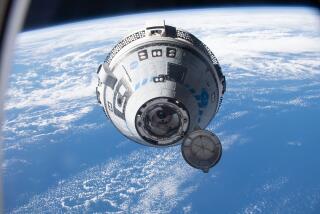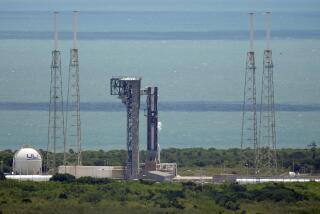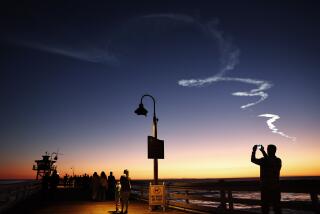Columbia Astronauts Launch Navy Satellite
CAPE CANAVERAL, Fla. â The Columbia astronauts launched a Navy communications satellite today, dispatching the relay station like a giant Frisbee, and closed in on a falling science satellite for a space rescue Friday.
âIt was an outstanding morning,â said flight director Granvil Pennington. He also had praise for Columbia, the oldest shuttle in the U.S. space fleet. âItâs a great ship up there theyâre flying in and it continues to perform beautifully.â
As Columbia approached the Equator east of Africa, astronaut David Low launched the Syncom F5 satellite at 5:19 a.m. PST by pressing âarmâ and âfireâ switches in the shuttleâs cockpit after a series of checks to make sure the costly spacecraft was ready for departure.
On Lowâs command, powerful springs pushed against one side of the 15,286-pound satellite, forcing it out of Columbiaâs cargo bay like a slowly spinning Frisbee.
âAnd Houston, we had a good deploy,â Low radioed mission control as the satellite slowly rolled away into space.
Forty-five minutes later, with the shuttle a safe distance away, an on-board solid-fuel rocket ignited and burned for 61 seconds to begin the relay stationâs journey to its final orbit 22,300 miles above the Equator.
Low, 33, and his crew mates--commander Daniel Brandenstein, 46, co-pilot James Wetherbee, 37, Bonnie Dunbar, 40, and Marsha Ivins, 38--were launched Tuesday on a 10-day flight to deploy Syncom and to rescue the Long Duration Exposure Facility, an 11-ton science package that is falling back to Earth.
Columbia is chasing the LDEF through space toward a planned Friday morning rendezvous. By midday today the shuttle was about 880 miles behind the satellite and closing in at a rate of 62 miles per orbit, NASA officials said.
When the shuttle catches up to the satellite, it will grab it with a robot arm and bring it into the payload bay for return to Earth.
The scientific satellite was put in space by a shuttle crew in April, 1984. NASA scientists consider its rescue crucial because it carries 57 experiments testing the effects of prolonged exposure to space on everything from tomato seeds to spacecraft materials.
âI think weâre in excellent shape for a Friday meeting,â said NASAâs Robert Castle. âThe vehicleâs in good shape, the trajectories are all lining upâ and Isaac Newton âwould have been very happyâ with the shuttleâs performance.
Columbia is scheduled to glide to a night landing Jan. 19 at Edwards Air Force Base.
More to Read
Sign up for Essential California
The most important California stories and recommendations in your inbox every morning.
You may occasionally receive promotional content from the Los Angeles Times.










